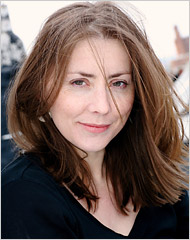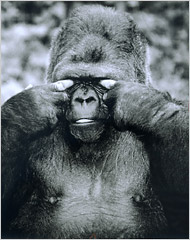| Want to send this page or a link to a friend? Click on mail at the top of this window. |
| More Books and Arts |
| Posted August 2, 2007 |
| The First World | |||||||
| The Search for the | |||||||
| Origins of Language | |||||||
| By Christine Kenneally | |||||||
| 357 pages. Viking. $26.95. | |||||||
|
A LL branches of science search for origins. Biologists want to know how life on earth began. Astronomers want to know how the universe got started. Even in mathematics, questions about how different numerical systems came to be constitute a legitimate line of inquiry.
 |
Marcia Cirello Photography |
| Christine Kenneally |
Linguists are different. In the middle of the 19th century, the main professional bodies governing linguistic research formally banned any investigation into the origins of language, regarding it as pointless. The topic remained disreputable for more than a century, but in the last decade or so, language evolution has eased toward the front burner, attracting the attention of linguists, neuroscientists, psychologists and geneticists. Their search is the subject of “The First Word,” Christine Kenneally’s lucid survey of this expanding field, dedicated to solving what she calls “the hardest problem in science today.”
One nut to crack is the nature of language itself, and here Ms. Kenneally introduces the unignorable presence in virtually every linguistic debate, Noam Chomsky. Mr. Chomsky and his many adherents regard language as a uniquely human endowment, centered in a specific area of the brain. It gives every living person the ability, unsought, to generate infinite strings of sentences in infinite combinations. Animals, in this view, do not have language, nor do they think. The reasons that humans speak, or how language might have made its way to the human brain, do not matter. It may simply be that in a linguistic version of the big bang, a language mutation suddenly appeared, and that was that.
This view now faces many rivals. The big-bang theory has been countered by linguists who believe that just as the eye evolved to meet a need for vision, language evolved to meet the need for communication. Ms. Kenneally ushers onto the stage researchers who have discovered that many animal species possess languagelike skills previously unimagined and, without benefit of syntax or words, have a complicated inner life. They believe that the study of animal language and gestures could shed light on a possible protolanguage stage in human development.
The idea that language is restricted to a specific area of the brain has been more or less discarded. Brain researchers now believe that language tasks are assigned throughout the brain. Moreover, some linguists now believe that language is a two-way street. It’s not something emanating from the brain of a communicating human. It actually changes the processes of the brain. Stroke victims suffering from aphasia, a condition involving language loss, do not simply find it difficult to communicate, they also find it more difficult to categorize, remember and organize information.
One of Ms. Kenneally’s most intriguing scientists, Simon Kirby, a linguist at the University of Edinburgh who works with computer models, has proposed the idea that language might be a self-evolving phenomenon. Somewhat like a computer virus, it changes and adapts to survive.
Ms. Kenneally, a linguist trained at the University of Cambridge, covers an enormous expanse of ground as she brings the reader up to date on developments in a wide variety of disciplines touching on language evolution. At times, she lapses into a somewhat mechanical recitation of experiments, papers and positions, which she tries to enliven, in vain, by inserting long, unedited quotations from her interview subjects that could just as well have been paraphrased.
On the plus side, she explains difficult ideas concisely and clearly, and she maintains a firm grip on the steering wheel, moving the overall argument along in a straight line. Above all, she is scrupulously fair-minded. Although obviously taken with the idea of language evolution and language acquisition as a continuum seen in primitive form in other species, she gives Mr. Chomsky his due, despite his withering scorn for most of the ideas she presents, and defends him from his most vehement detractors.
Best of all, Ms. Kenneally zeroes in on a host of fascinating experiments. What happens when one ape trained in sign language meets another equally proficient ape for the first time? Not communication, it turns out. “What resulted was a sign-shouting match; neither ape was willing to listen,” Ms. Kenneally reports.
 |
Dr. Ronald Cohn/Gorilla Foundation/PBS |
| Koko, a gorilla with a vocabulary. |
Mr. Kirby, the computer modeler, devised an experiment in which subjects were shown objects on a screen along with words describing the objects in what was represented as an invented alien language. The subjects were asked to learn the language. In testing one student after the other, however, Mr. Kirby added new objects to the ones already shown, whereupon the subjects unthinkingly generated new words and combinations. These changes were added to the core list and passed along to successive subjects who, trying to master the language created, in part, by each of their predecessors, made their own additions and changes.
| ________________________ | |
| Big-bang linguistics theories are rivaled by studies of animals and computer viruses. | |
| ________________________ |
“Except for the initial random language given to the first subject, there was no alien language, only the contributions of each individual, which were culturally transmitted from generation to generation,” Ms. Kenneally writes. “Each subject in the experiment believed that he was simply giving back what he had learned, but instead the language was evolving.”
In similar fashion, researchers have been looking at Internet sites that generate their own protolanguages and linguistic structures.
Ms. Kenneally concludes with a little experiment of her own. She asks many of the subjects she interviewed to imagine a group of infants stranded on the Galapagos Islands, provided with all the necessities of life but no access to speech. Would they create a language? How many babies would it take, what might their language be like, and how would it change over the generations?
The answers range from no language to sign language to a full-fledged language in three generations. The real point is that Ms. Kenneally could gather 15 linguists willing to think about the problem. Onward to the first Neanderthal dictionary.
Copyright 2007 The New York Times Company. Reprinted from The New York Times, TheArts, of Wednesday, August 1, 2007.
| Wehaitians.com, the scholarly journal of democracy and human rights |
| More from wehaitians.com |